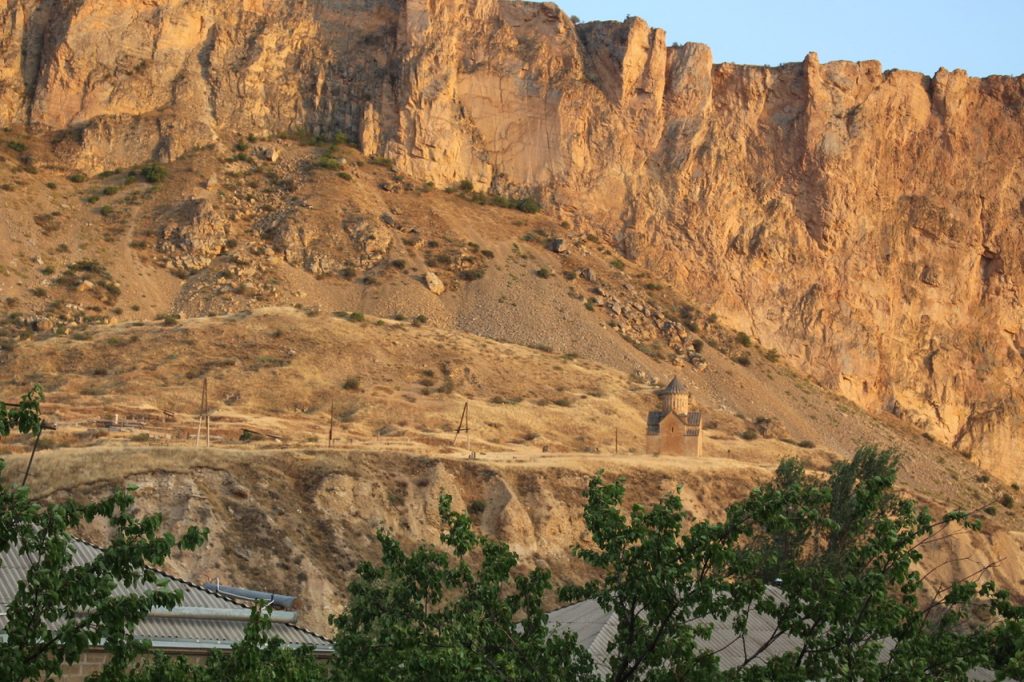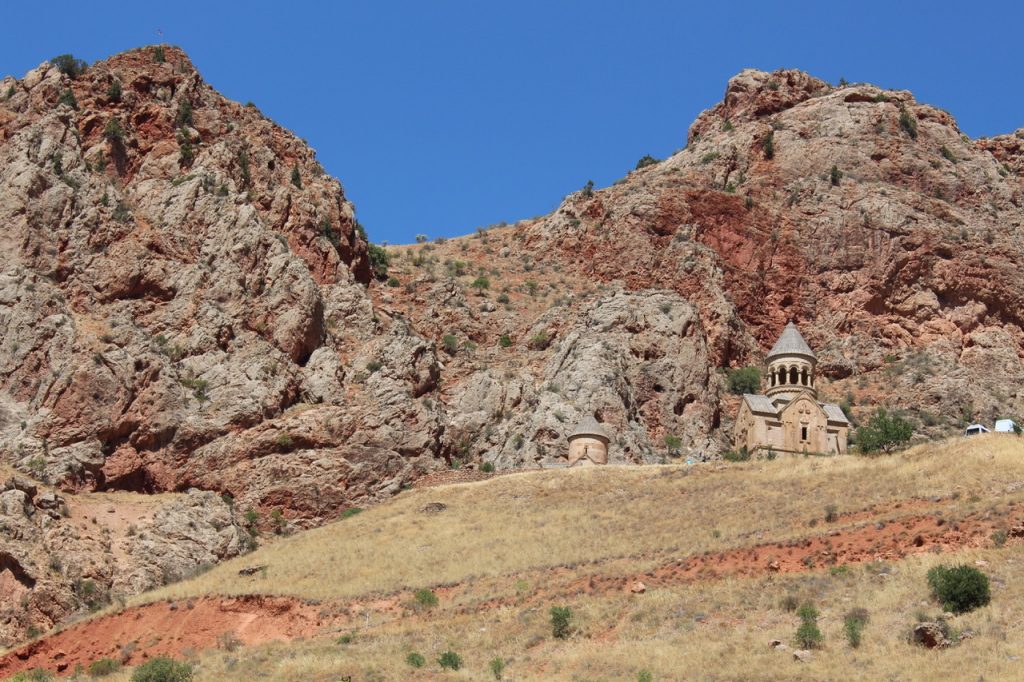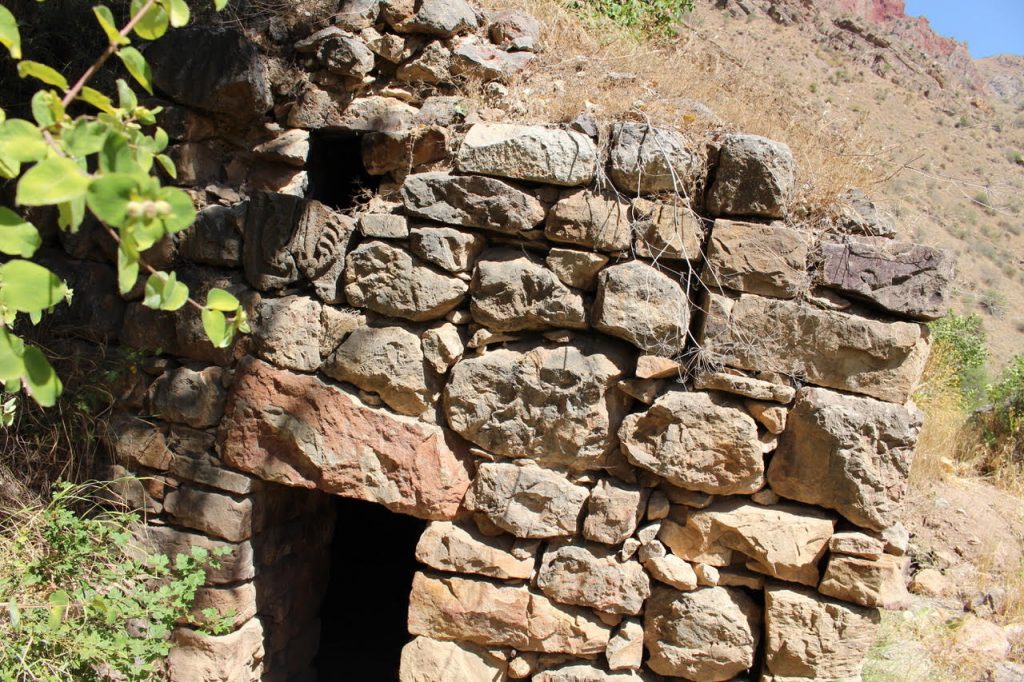South of Yerevan, along the main road to Goris is the large village of Areni in the marz (province) of Vayots Dzor. On the roadside just before Areni are vendors selling homemade wine in plastic soda bottles, others selling fruit, and on the left is the Areni Wine Factory.
Areni lies in the valley to the right. Above the village, against a backdrop of pastel colored cliffs is the small Surb Astvatsatsin church (1321). A short dirt road leads to the church with a number of tombstones next to it. Next to the church was also a castle belonging to the Orbelians, although little remains of the castle. The Orbelian family included ruling princes of Syunik, military officials, and high-ranking clerics including Bishop Stepanos Orbelian (1250-1305). Stepanos Orbelian was consecrated the Metropolitan (chief bishop) of Syunik , or Sisakan, while in Cilician Armenia on Easter 1286. Upon returning to Syunik the monasteries of Noravank and Datev came under his jurisdiction. Stepanos Orbelian was also a noted historian, known mostly for his The History of the Province of Syunik.
While visiting Surb Astvatsatsin, my friend and I struck up a conversation with a villager who was repairing his motorcycle, which had just broken down. He suggested we visit Noravank, about a 15-minute drive from there. He had a relative who worked there. We politely declined, explaining that though Noravank was indeed spectacular site, we had other places to get to which we had not yet seen, and our time was short. During our brief conversation he asked if we had seen the Surb Pokas church. Orbelian’s history mentions an ancient church in the region with miraculous curative waters. I wondered if Surb Pokas was it. I had previously looked for this church but had not found it; I was not even sure it really existed.
The villager offered to come with us and show us the church. We drove down the narrow valley, passing Noravank, which was situated high up to the left above the valley floor. After a short distance the road ended. We then scrambled up hill over rocks and along a brook to a small, crudely built chapel or church, most of which was dug into the side of the hill. Under its altar was a two-three foot square well filled with water.
Our guide indicated that the water produced miraculous cures. A few days ago he could not raise his right arm over his shoulder; but he then rubbed some of the water on his arm, and his arm was cured. He invited me to take a sip of the water with a cup placed nearby. Not wanting to offend him, I took a small sip. The water had an oily texture to it. On the wall of the church were a couple of photocopies of articles indicating that this indeed was the church described by Stepanos Orbelian.

Inside Surb Pokas church with our guide, the rectangular well is below the altar (Photo: Joseph Dagdigian)
Oreblian’s history describes the church of Surb Karapet, and then another nearby church, Surb Pokas (Phocas). The quotation below is from the translation of Orbelian’s history by Robert Bedrosian, which is freely available online:
There was also on a rocky hill another church in the same valley, built in the name of the blessed patriarch Phocas. Inside the church a small stream of water flowed under the bema and, mixed with the water, was a curative oil. We have heard from ancient traditions that some of the relics of the blessed patriarch Phocas had been brought and deposited there, and thus the place was called Phocas. Astonishing marvels occurred there, for all sorts of incurable and untreatable human ailments—syphilis, leprosy, and wounds which had putrified over a long time, were cured if the sufferers went there in faith and washed in the water and anointed themselves with the oil. If it was a fatal [illness], then the sufferer would die at once. For this reason, the place was greatly renowned throughout the land.
Though I had searched for this church before, I had only a vague idea of where to look for it. A chance meeting with a stranger showed the way!
Saint Pokas was the Bishop of Sinop on the Black Sea coast. He was charitable to the poor, and miraculously cured the blind. Becoming a bishop, he was persecuted for his Christianity and was ordered to be killed by the local king, King Trayanos. Saint Pokas invited some of the king’s soldiers to his house for dinner, even though these soldiers had orders to kill him on sight. Then Pokas revealed that he was the person the soldiers were ordered to kill. The soldiers pleaded with Pokas to renounce Christianity, but Pokas could not. He was martyred in 117 AD. Somehow his relics ended up in Armenia.
Source: Armenian Weekly
Link: Unseen Armenia: Surb Pokas



